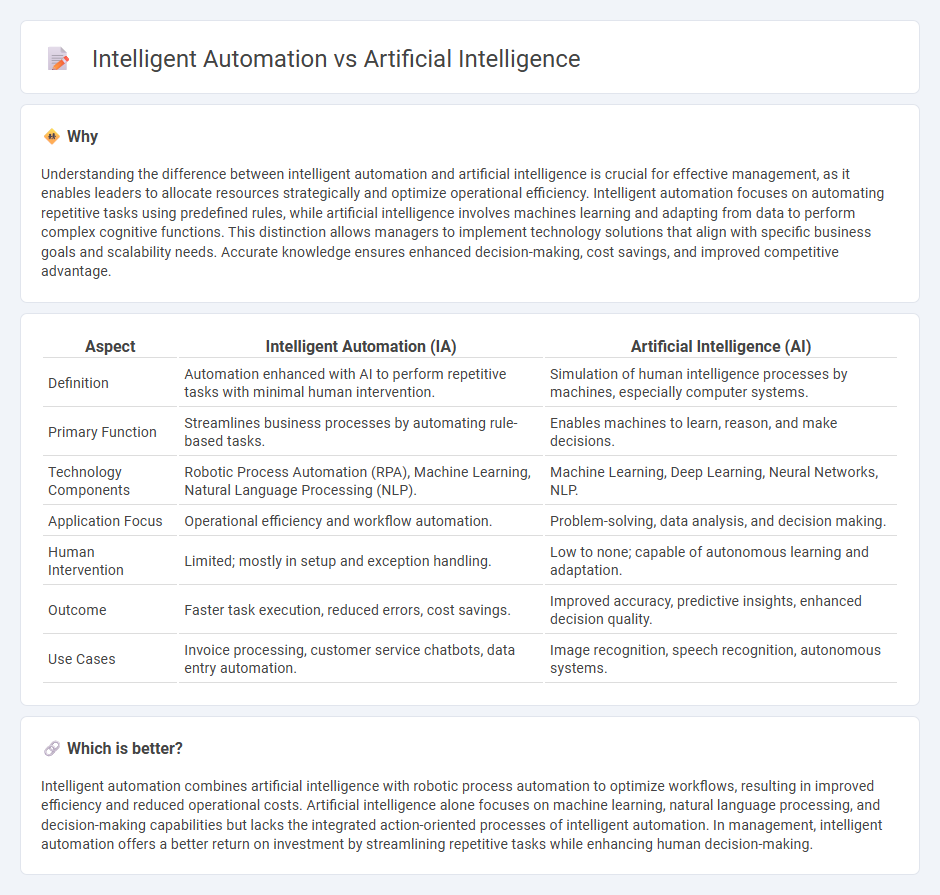
Intelligent automation combines artificial intelligence, robotic process automation, and machine learning to streamline complex business processes efficiently. Artificial intelligence focuses on creating systems capable of performing tasks that normally require human intelligence, such as reasoning, learning, and problem-solving. Explore the distinctions between intelligent automation and artificial intelligence to optimize your organization's management strategies.
Why it is important
Understanding the difference between intelligent automation and artificial intelligence is crucial for effective management, as it enables leaders to allocate resources strategically and optimize operational efficiency. Intelligent automation focuses on automating repetitive tasks using predefined rules, while artificial intelligence involves machines learning and adapting from data to perform complex cognitive functions. This distinction allows managers to implement technology solutions that align with specific business goals and scalability needs. Accurate knowledge ensures enhanced decision-making, cost savings, and improved competitive advantage.
Comparison Table
| Aspect | Intelligent Automation (IA) | Artificial Intelligence (AI) |
|---|---|---|
| Definition | Automation enhanced with AI to perform repetitive tasks with minimal human intervention. | Simulation of human intelligence processes by machines, especially computer systems. |
| Primary Function | Streamlines business processes by automating rule-based tasks. | Enables machines to learn, reason, and make decisions. |
| Technology Components | Robotic Process Automation (RPA), Machine Learning, Natural Language Processing (NLP). | Machine Learning, Deep Learning, Neural Networks, NLP. |
| Application Focus | Operational efficiency and workflow automation. | Problem-solving, data analysis, and decision making. |
| Human Intervention | Limited; mostly in setup and exception handling. | Low to none; capable of autonomous learning and adaptation. |
| Outcome | Faster task execution, reduced errors, cost savings. | Improved accuracy, predictive insights, enhanced decision quality. |
| Use Cases | Invoice processing, customer service chatbots, data entry automation. | Image recognition, speech recognition, autonomous systems. |
Which is better?
Intelligent automation combines artificial intelligence with robotic process automation to optimize workflows, resulting in improved efficiency and reduced operational costs. Artificial intelligence alone focuses on machine learning, natural language processing, and decision-making capabilities but lacks the integrated action-oriented processes of intelligent automation. In management, intelligent automation offers a better return on investment by streamlining repetitive tasks while enhancing human decision-making.
Connection
Intelligent automation leverages artificial intelligence technologies such as machine learning, natural language processing, and computer vision to enhance decision-making and streamline complex management processes. By integrating AI algorithms, intelligent automation systems can analyze vast datasets, predict outcomes, and optimize workflows without human intervention. This synergy enables organizations to achieve higher operational efficiency, reduce errors, and drive data-driven strategies in management.
Key Terms
Machine Learning
Artificial intelligence (AI) leverages machine learning algorithms to enable systems to learn from data and improve their performance without explicit programming, whereas intelligent automation (IA) integrates AI with robotic process automation to streamline complex business workflows. Machine learning serves as the core technology in AI, providing predictive analytics and pattern recognition that empower IA to execute adaptive, data-driven tasks. Explore the latest advancements in AI and IA to understand how machine learning transforms operational efficiency.
Robotic Process Automation (RPA)
Artificial intelligence (AI) enhances Robotic Process Automation (RPA) by enabling robots to handle unstructured data and make decisions using machine learning and natural language processing. Intelligent automation combines AI technologies with RPA to streamline complex workflows, improving efficiency and accuracy beyond simple rule-based tasks. Explore how integrating AI with RPA transforms digital operations and drives business innovation.
Decision-Making
Artificial intelligence (AI) enhances decision-making through advanced data analysis, pattern recognition, and predictive capabilities, enabling systems to learn and adapt autonomously. Intelligent automation integrates AI with robotic process automation (RPA) to streamline repetitive tasks while improving operational efficiency and decision accuracy in real-time workflows. Explore the nuances between AI and intelligent automation to optimize your organization's strategic decision-making processes.
Source and External Links
What Is Artificial Intelligence (AI)? - Artificial intelligence is a set of technologies allowing computers to perform advanced functions like data analysis, image recognition, and speech understanding.
Artificial intelligence - Artificial intelligence refers to the capability of computational systems to perform tasks typically associated with human intelligence, such as learning and problem-solving.
Artificial Intelligence (AI): What it is and why it matters - Artificial intelligence enables machines to learn from experience, perform human-like tasks, and automatically derive insights from large datasets using algorithms and neural networks.
 dowidth.com
dowidth.com